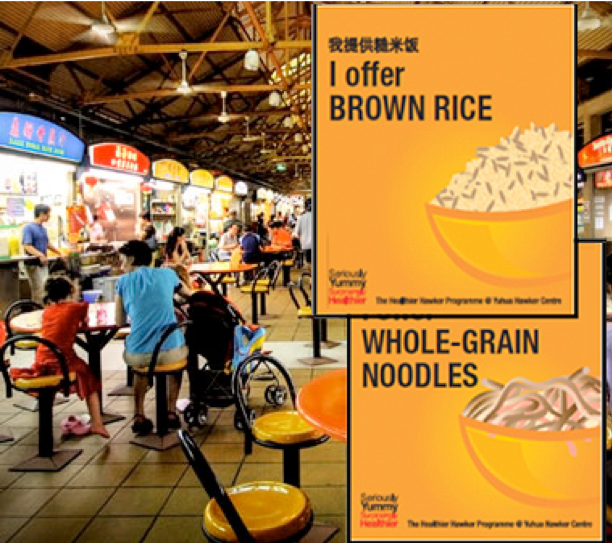Share This
Faced with rapidly rising rates of obesity and type 2 diabetes, the Singaporean government’s Health Promotion Board (HPB) has been working hard to promote a major shift toward whole grains in a country where white rice and refined grain noodles make up a huge part of the average consumer diet. In fact, in 2010 when the government in Singapore started heavily promoting wholegrains, the country had some of the lowest whole grain consumption in the world – ranking #104 out of 113 countries surveyed in a study conducted by the Global Nutrition and Policy Consortium based at Tufts University. At the time, just 3% of calories in the average Singaporean diet came from whole grains, a far cry from the HPB’s 50g recommendation for daily intake.
Even though whole grains are a part of traditional diets in just about every part of world, the prevalence of refined grain products in recent decades has erased a lot of that cultural memory. The HPB recognizes that one of the challenges they face is that many consumers believe “our ancestors were rice eaters with little ill effect.” People have forgotten that, “while rice eating is culturally ingrained in Asia, the norm used to be unpolished rice, not polished white rice, which only became a feature of [the] Asian diet in the last 50 to 60 years.”
Using Supermarket Discounts to Encourage New Habits
Targeting consumer habits at home, the HPB has created partnerships with major supermarket chains, encouraging them to offer discounts and promotions on whole grain rice and to highlight with signage that brown rice and red rice are healthier options than white rice. Supermarkets working with the HPB also distribute educational material and “nutrition toolkits” which include a nutrition guide and recipe book to help make it easy for consumers to make the switch to whole grains.
All this work to educate consumers and promote whole grain purchases has paid off. Over the course of three years of promotional activity, the supermarket chain Cold Storage reported a 15% increase in whole grain rice sales and a 10% decrease in white rice sales. Singapore’s largest supermarket chain, NTUC FairPrice, has recently reported even more impressive results, citing a 40% increase in brown rice sales over a period of six months after offering discounts on whole grain rice products.
Whole Grains on the Go: Increasing Accessibility and Availability
When whole grains are more expensive or hard to find, consumers are much less likely to choose them. And in a country like Singapore, where a third of the population eats out more than seven times a week, making whole grain options both available and affordable for folks dining outside the home is a priority when it comes to changing consumer habits. Recognizing this, the HPB has created a Healthier Dining Programme in an effort to bring more whole grain options (and other healthy alternatives) to restaurants, food courts, and cafes. Under this program, the government offers food and beverage businesses the opportunity to apply for grant funding to develop and promote healthier menu options.
The HPB has also developed a program specifically targeting Hawker Centres, which are open-air food courts with multiple stalls, many of which serve inexpensive rice- or noodle-based meals. About 80% of Singaporeans eat at a Hawker Centre at least once a week, so the potential nutritional impact of incorporating more whole grains into these foods is huge. In partnership with food vendors and their suppliers, the HPB has worked to develop and market partially-whole-grain noodles and partially-whole-grain rice blends which are made available to consumers at an equal or reduced price compared with their fully-refined-grain counterparts.
Since 2014, the impact and success of this program has grown. In fact, as of April 2018, more than 5,000 hawker stalls had partnered with the HPB to offer whole grain options or meals that have fewer calories, lower sugar levels, or healthier fats than the standard hawker fare. In a June 2018 blind taste test of whole grain and refined grain noodles at the Geylang Serai Hawker Centre, 9 out of 10 people preferred the whole grain noodle dish (mee goreng), describing it as “having more bite,” “lighter,” and “less alkaline in taste.”
By April next year, HPB hopes that 4 in 10 hawker stalls in the country will be on board. It’s all about trying to make sure “there is always a healthier option, whatever your budget is,” Ann Low, HPB’s deputy director of the obesity prevention management division, explained to a Channel NewsAsia reporter.
If you’re interested in learning more about whole grains and the Asian Diet, check out our new handout and our recently updated Asian Diet Pyramid. (Caroline)




Comments
Add a Comment